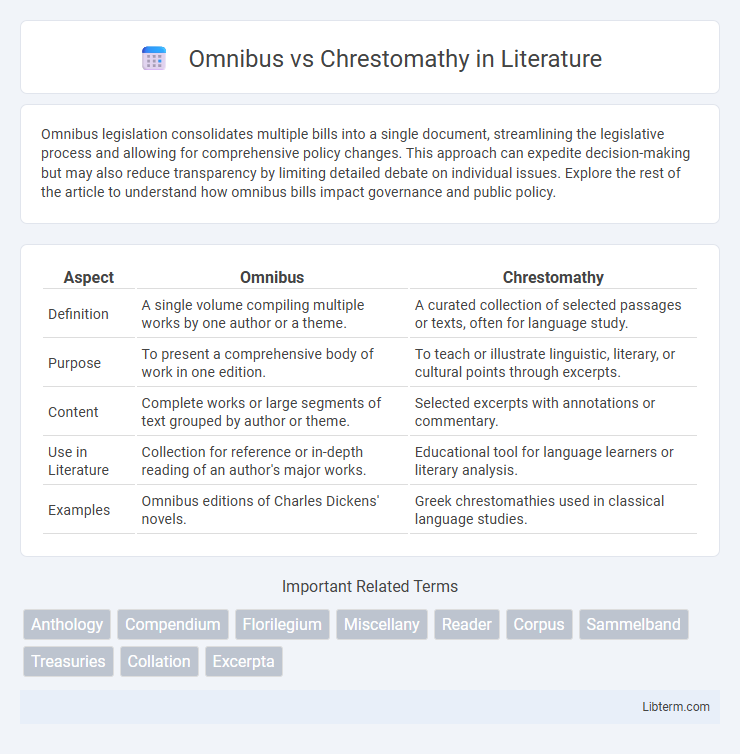Omnibus legislation consolidates multiple bills into a single document, streamlining the legislative process and allowing for comprehensive policy changes. This approach can expedite decision-making but may also reduce transparency by limiting detailed debate on individual issues. Explore the rest of the article to understand how omnibus bills impact governance and public policy.
Table of Comparison
| Aspect | Omnibus | Chrestomathy |
|---|---|---|
| Definition | A single volume compiling multiple works by one author or a theme. | A curated collection of selected passages or texts, often for language study. |
| Purpose | To present a comprehensive body of work in one edition. | To teach or illustrate linguistic, literary, or cultural points through excerpts. |
| Content | Complete works or large segments of text grouped by author or theme. | Selected excerpts with annotations or commentary. |
| Use in Literature | Collection for reference or in-depth reading of an author's major works. | Educational tool for language learners or literary analysis. |
| Examples | Omnibus editions of Charles Dickens' novels. | Greek chrestomathies used in classical language studies. |
Defining Omnibus: Overview and Key Features
An omnibus is a comprehensive publication that compiles multiple works by a single author or on a specific theme into one volume, offering a unified reading experience and convenient access to a broader range of content. Key features include extensive length, thematic or authorial cohesion, and the potential to present works in chronological or curated order, enhancing both accessibility and scholarly value. This format contrasts with a chrestomathy, which typically contains selected excerpts meant for educational purposes rather than complete works.
Understanding Chrestomathy: Meaning and Purpose
Chrestomathy refers to a curated collection of literary passages or texts selected to illustrate language use, style, or thematic elements, serving educational and linguistic analysis purposes. Unlike an omnibus, which compiles complete works or extensive collections, a chrestomathy targets specific excerpts to facilitate focused learning and comprehension. Its purpose is to enhance understanding of language patterns, cultural context, and authorial techniques through selected representative samples.
Historical Background: Omnibus vs Chrestomathy
The term "Omnibus" originated in the early 19th century, initially describing collections of various works or writings compiled into one volume, often aimed at accessibility and convenience. In contrast, "Chrestomathy" has its roots in classical education, deriving from the Greek word "chrestos," meaning useful, and traditionally signifying a curated anthology of literary extracts designed for language learning and scholarly study. The historical use of Omnibus reflects general aggregation for readership breadth, while Chrestomathy emphasizes pedagogical selection to facilitate language acquisition and cultural literacy.
Usage in Literature and Academia
An omnibus edition compiles an author's complete works or a series into a single volume, serving as a comprehensive resource often utilized in literature studies for in-depth analysis. A chrestomathy, in contrast, curates selected passages from various authors or texts, typically used in academia to aid language learning, literary criticism, or thematic studies by providing representative samples. Both formats support scholarly research, but omnibuses enable extensive reference while chrestomathies emphasize curated content for educational and analytical purposes.
Structure and Format Differences
An omnibus compiles multiple works, often previously published, into a single volume, maintaining each original piece's complete structure and order. A chrestomathy, by contrast, selectively extracts and arranges textual excerpts or passages from various sources to highlight specific linguistic or thematic features. The omnibus preserves full-length narratives or texts, whereas the chrestomathy emphasizes curated samples for study or analysis.
Application in Modern Publishing
Omnibus editions compile multiple related works or volumes by a single author or on a specific theme, enhancing reader convenience and preserving comprehensive collections in modern publishing. Chrestomathies, often curated for educational use, present selected excerpts from various authors or texts to facilitate language learning or thematic study. Modern publishers leverage omnibus editions for marketability and collector appeal, while chrestomathies serve academic and pedagogical purposes, adapting to digital formats for interactive learning experiences.
Advantages of an Omnibus Collection
An omnibus collection compiles multiple related works into a single volume, offering readers convenience and cost-efficiency by reducing the need to purchase individual books separately. It enhances continuity and immersion by providing seamless reading experiences without interruptions caused by switching between editions. Omnibus editions often include exclusive content, such as introductions, annotations, or artwork, enriching the overall value for collectors and enthusiasts.
Benefits of a Chrestomathy
A chrestomathy offers curated content specifically selected to aid language learners or scholars, making it ideal for focused study and gradual acquisition of linguistic skills through authentic texts. Unlike an omnibus, which compiles complete works without selective emphasis, a chrestomathy highlights representative samples that illustrate key vocabulary, grammar, and stylistic features. This targeted approach enhances comprehension and retention by exposing readers to varied yet manageable linguistic examples within a cohesive framework.
Common Misconceptions and Clarifications
Omnibus collections are often mistaken for chrestomathies, but they serve distinct purposes: omnibuses compile complete works or series for convenience, while chrestomathies select representative excerpts to aid language learning or literary analysis. A common misconception is that both focus on aggregation, yet chrestomathies emphasize pedagogical value by showcasing stylistic variety and linguistic features. Clarification lies in understanding that omnibuses prioritize comprehensiveness, whereas chrestomathies prioritize educational breadth and context.
Choosing Between Omnibus and Chrestomathy: Practical Considerations
Choosing between omnibus and chrestomathy editions depends on the reader's purpose and scope of study; an omnibus compiles entire works for comprehensive reading, while a chrestomathy offers selected excerpts for targeted learning or analysis. Omnibus editions provide value for deep immersion in a single author's complete writings, whereas chrestomathies support comparative studies or language acquisition through curated texts. Practical considerations include the available time, desired depth of understanding, and specific educational goals.
Omnibus Infographic

 libterm.com
libterm.com